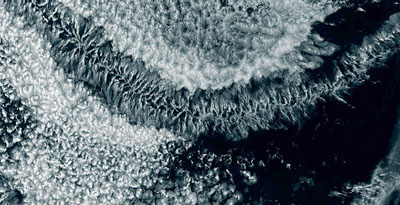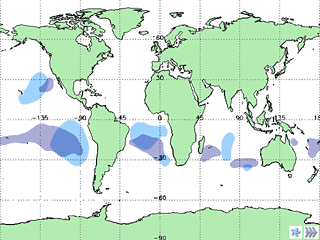
"Convective Cells"
"Actinoform" Structure(AFS)
The Actinoform Structure (named after the greece actinos,
a beam) may have two forms: 
- round or oval cloud formation where there appear to be radial symmetry
and sometimes even helical motion. These formations, when seen from
high above, resemble veins of a leafe.
In this case the dimension of the structure is from 80 to 400 km (seldom
more).
- long (up to thousands of kilometers) bands that consist of "accrete"
cells.
When seen from above this structure looks like a huge centipede with
well-marked spine and multiple ribs.
In this event the width of the band is 70-120 km, and the length is
from several hundreds to 1-1.5 thousand (or even more) km.
The cloud top height is from 0.6 - to 2 km, seldom to 2.5.
It is interesting to note that according to the new MERIS Level 2 data
the cloud top height in the centre of round structures (as well as the
"spine" of the band structures) is always 300-700 m lower than the cloud
top height of the clouds located in the periphery of the structures.
The Actinoform Structure emerges at the border of the fields
of the open and close convective cells using the open convective cells
as the substrate.
Large (from ~200 km) round/oval structures may attract neighboring closed
convective cells. Segregating they may later on form isolated (located
outside the fields that have created them) vast elements in which the
general circulation seems to be similar to that one that takes place in
open convective cells. Such structures often separate from the convective
cells that have created them and exist on its own, sometimes revolving
around its own centre, even forming an "eye".
On their part the band structures also demonstrate sufficient stability
and segregate along the low-level streams of the air most often in parallel
with the equator.
The Actinoform Structure mainly consists of stratocumulus
clouds; quite often there are stratus clouds along the ridge of the "ribs"
and small cumulus - in their periphery.
Actinoform Structures are not seen frequently, though they
can be seen quite often.
They can be observed where there are large fields of open and close convective
cells: mostly over East Pacific not far from the Peruvian cost, as well
as not far from the Atlantic coast of Brazil and above the Indian Ocean
close to the coast of Western Australia.
According to some weather reports the clouds of these structures are the
source of drizzle.
Not often it is possible to watch large (up to 600 - 700
km) cloud structures bearing some similarities to the Actinoform structure
and undergoing dissociation (possibly the increase of the dimension causes
the structural instability). It is hard to say exactly if such enormous
formations belong to the Actinoform structure, because there is no valid
physical description of this structure yet.
|

